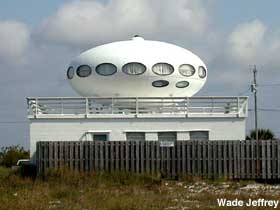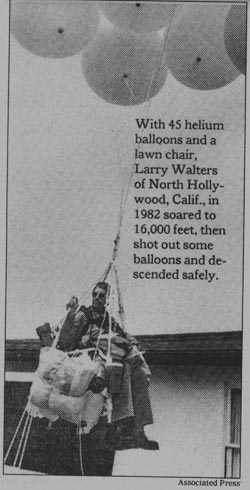



Clearly there's a shape-shifting aspect to this craft....
Posted on 02/02/2006 12:35:43 PM PST by BenLurkin
PALMDALE - A mysterious flying craft seen hovering over Air Force Plant 42 Tuesday morning was the latest creation from Lockheed Martin Aeronautics Co.'s famed Skunk Works on its maiden flight. The blimp-like aircraft, known simply as P791, is a proof-of-principle vehicle to help engineers learn more about technology and aerodynamics for such airships.
"Lockheed Martin is testing a small-scale airship as part of an internal research and development effort," Lockheed spokeswoman Dianne Knippel said.
The large white airship is shaped somewhat differently from a traditional blimp, with twin torpedo-like sections joined in the center and a cockpit beneath. Four airlifters move the vehicle on the ground and in the air.
The company, known for its advanced technology developments conducted in secrecy, is not releasing any additional information about the project at this time.
The airship likely will be seen flying for the next six weeks, generally during the morning hours, Knippel said.
(Excerpt) Read more at avpress.com ...




Clearly there's a shape-shifting aspect to this craft....
Back when The Skunk Works in Palmdale used to have a Gift Shoppe (honest!) I ordered some knickknacks from there -- refrigerator magnets, coffee mug, license plate frame, etc.
The box they sent the stuff in was a standard USPO mailing box sealed with the cheeriest Smiley Face tape and cushioned inside with the local newspaper. There was also a big Smiley Face dran on the enclosed receipt.
They're a cheery bunch there at Black Ops Central.
Lockheed was proposing long range unmanned airships at least back in the late 1980s to my knowledge. Back then, the idea was to do ASW patrol over the Denmark Strait area to catch Russian subs coming into the Atlantic. The ship was to be propelled by small hydrogen powered engines. I never could understand how such a craft could deal with 100+ knot jetstream winds.
dran = drawn
They would be above them.
Alien technology. Now we have to figure out why they preferred blimps.
Looks like Oprah in tights.

Art Bell ping!
In this article DID explains the concept, details the contractors and contracts involved in this initial award (including a few updates), and lays out the program's structure...
DARPA notes that a key goal of the Walrus program is to establish clear and credible solutions that provide confidence that earlier airship-era limitations will be overcome. In particular, an early focus of the program will be the investigation of advanced breakthrough technologies that will support the development of innovative lift and buoyancy concepts that do not rely on off-board ballast.
Concept & Key Technologies
(click to view full)The Walrus program will develop and evaluate a very large airlift vehicle concept designed to control lift in all stages of air or ground operations including the ability to off-load payload without taking on-board ballast other than surrounding air. This is obviously rather important when offloading up to 2 million pounds of personnel and military equipment in remote areas. In distinct contrast to earlier generation airships, the Walrus HULA (Hybrid Ultra Large Aircraft) will be a heavier-than-air vehicle and will generate lift through a combination of aerodynamics, thrust vectoring and gas buoyancy generation and management.
The Walrus operational vehicle (OV) is intended to carry a payload of 500-1,000 tons (that's 1-2 million pounds) up to 12,000 nautical miles, in less than seven days and at a competitive cost. Given these enormous capacities, they would mostly be used to deploy full-scale fighting units (for example, the components of an Future Combat Systems Army Unit of Action) quickly, getting them to their site with a minimum of equipment reassembly work required. The ideal is that transported forces should fully ready to fight within six hours.
Initial conceptions call for the Walrus to operate without significant infrastructure and from unimproved landing sites, including rough ground having five-foot-high obstacles like boulders, shrubs, et. al. Additionally, Walrus should be capable of performing theater lift and supporting sea-basing or even persistence missions like communications and surveillance.
DARPA says that advances in envelope and hull materials, buoyancy and lift control, drag reduction and propulsion have combined to make this concept feasible. Technologies to be investigated in the initial study phase include vacuum/air buoyancy compensator tanks, which provide buoyancy control without ballast, and electrostatic atmospheric ion propulsion.
The Contractors
The two contractors receiving Walrus Phase I awards are:
Lockheed Martin Corp. Advanced Development Programs in Palmdale, CA ($3 million). More commonly known by its colloquial name "Skunk Works," it has designed and produced legendary aircraft like the U-2 and SR-71. Aeros Aeronautical Systems Corp. in Tarzana, CA ($3.3 million) Another contractor, meanwhile, notes that:
"Millennum Airship Inc. was notified by DARPA on June 13, 2005 that we were not one of the two selected contractors. However, both our ITAMMS and Vacustat technologies are unique and important to the viability of this program. We have been contacted by both winners, Lockheed Martin and Aeros Aeronautical Systems, about possibly integrating our two technologies into their systems. Currently, we have been invited to Lockheed Martin for a meeting on October 24 to further examine the combined opportunities."
Program Structure
SkyFrieghter
(click to view full)The Walrus program will develop an operational vehicle concept design and required breakthrough technologies and will conduct risk reduction demonstrations of these new technologies.
During the program's first phase, a 12-month analytical effort, the two contractor teams will conduct trade studies to determine which OV design concept most satisfies the operational tasks and optimizes design capability. Phase I will explore various vehicle configurations (rigid, non-rigid and semi-rigid), and will conclude with a concept design review of the OV and the supporting technology development plan for risk reduction demonstrations including the ATD vehicle.
DARPA will select one contractor team to enter the second phase, which will be a demonstration effort spanning three years. During phase II, the program will refine the Walrus' design needs, identify its potential military use through modeling and studies, develop breakthrough technologies, and conduct risk reduction demonstrations of components and subsystems.
DARPA also notes that demonstrations will include flight tests of a Walrus Advanced Technology Demonstration (ATD) scaled aircraft. This is a fancy way of saying that under the $10 million Walrus advanced technology demonstration (ATD), they plan to flight-test a "significant-scale" lifting airship in 2008 with a payload capability of around 30 tons, comparable with a Lockheed Martin C-130.
These risk reduction demonstrations, including the ATD vehicle, are designed to establish a low-risk technology path for proving the Walrus concept and achieving the operating goals.
Additional Readings
See DARPA Release [PDF format] and DARPA Program web page. Gizmag - The Walrus: the US Army contemplates building an aircraft the size of a football field Millenium Airship, Inc. Skyfreighter. See also their ITAMMS technology for thrust/lift.
Dedicated LTA builder World SkyCat also failed to receive a DARPA contract. Their site is highly worthwhile, however, especially for all the variants of HULA craft they propose (and justify) for specialized uses, and their incorporation of operating cost figures. The economics of SkyGas and SkyPipeline were especially interesting, as commercial demand would push per-unit HULA costs down and ensure open production lines (and hence additional military procurement options) much more consistently than reliance on pure military orders.
(Originally published on August 30, 2005. Updated as new information has become available.)
Funnel the hot air from jet exhausts to inflate the balloon- would be very eff.


WHen I worked in Irvine Ca., Westinghouse was keeping a radar testing blimp at Tustin MCAS, Our offices were on the top floor of the citicorp building, about a mile from the airport.
One day as the blimp passed by, We went up on the roof to watch it , The Red Baron Pizza Biplane team was at the airport.
They took off, and formed up near the blimp.
It's probaly been since the 30's with Akron and Aacon, that blimps and biplanes flew together over LA.
Or the TR3-B Anti-Gravity Triangle.


Hmmmm . . . . very nice actually.
Just Damn! You can't even SEE that thing hovering over the
hanger!!!
Cool! Those look like flying domed stadiums... maybe the NFL should check them out.
Disclaimer: Opinions posted on Free Republic are those of the individual posters and do not necessarily represent the opinion of Free Republic or its management. All materials posted herein are protected by copyright law and the exemption for fair use of copyrighted works.